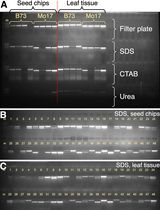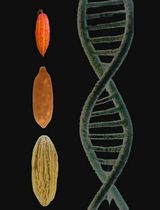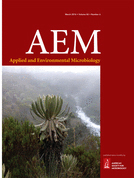- Submit a Protocol
- Receive Our Alerts
- Log in
- /
- Sign up
- My Bio Page
- Edit My Profile
- Change Password
- Log Out
- EN
- EN - English
- CN - 中文
- Protocols
- Articles and Issues
- For Authors
- About
- Become a Reviewer
- EN - English
- CN - 中文
- Home
- Protocols
- Articles and Issues
- For Authors
- About
- Become a Reviewer
Endophytic Microbial Community DNA Extraction from the Plant Phyllosphere
Published: Vol 7, Iss 4, Feb 20, 2017 DOI: 10.21769/BioProtoc.2142 Views: 11628
Reviewed by: Ramalingam BethunaickanAnonymous reviewer(s)

Protocol Collections
Comprehensive collections of detailed, peer-reviewed protocols focusing on specific topics
Related protocols

A β-glucuronidase (GUS) Based Bacterial Competition Assay to Assess Fine Differences in Fitness during Plant Infection
Julien S. Luneau [...] Alice Boulanger
Jul 5, 2022 3041 Views

An Effective and Safe Maize Seed Chipping Protocol Using Clipping Pliers With Applications in Small-Scale Genotyping and Marker-Assisted Breeding
Brian Zebosi [...] Erik Vollbrecht
Feb 5, 2025 1690 Views

Optimized Protocol for DNA Extraction in Three Theobroma Species
Angie F. Riascos-España [...] Pedro A. Velasquez-Vasconez
May 5, 2025 1862 Views
Abstract
The plant phyllosphere, which represents all plant parts that are above the ground, is considered one of the most extensive ecosystems to be colonized by microorganisms, both at the surface as epiphytes or as endophytes within the plant. These plant-associated microbial communities are reservoirs of microbial diversity and they can be important for plant health. The characterization of microbial communities in diverse plants, such as Espeletia plants that are endemic to the Paramo ecosystem in the Andes Mountains, can shed light regarding possible interactions among microorganisms and microbial functional properties. Obtaining DNA from plant endophytic microbial communities involves various steps to ensure that samples are free of contamination from microorganisms present on the plant surface (epiphytes). Plant leaves are first surface sterilized, cut into pieces, homogenized using glass beads, and then used for DNA extraction using a commercially available kit. DNA samples are then quantified and analyzed using Qubit® 2.0 for use in PCR amplification of 16S rRNA genes.
Keywords: EndophyteBackground
Extraction of endophytic DNA from plant samples has been done by several research groups and usually involves steps to minimize contamination from surface microbes. However, protocols must also be adapted to the plant material being studied and as such can incorporate different steps. Extraction of epiphyte DNA must also ensure that there is no contamination from endophytic microorganisms. The protocol described integrates elements from previous reports (Miles et al., 2012; Araujo et al., 2002), but was not identical given the characteristics of the plant material used. In this work we used leaves from Espeletia hartwegiana, a plant that is endemic to the Paramo ecosystem present in the Colombian Andean mountains. These leaves are characterized to be large and succulent with the presence of short hairs on the surface (pubescence) that require removal prior to leaf surface sterilization and DNA isolation. Here, although the pubescence is removed, the microorganisms associated with it are dislodged first to ensure a complete picture of the epiphyte community. In this case, sufficient DNA of good quality was recovered for PCR amplification and 16S rRNA gene analysis and for functional analysis using the GeoChip (Yan et al., 2015). Nonetheless, other downstream applications could require more DNA and hence more plant material.
Materials and Reagents
- Gloves
- 1.5 ml sterile microcentrifuge tubes
- 10, 100, 1,000 micropipette tips
- Sterile craft paper
- Ziploc bags (ethanol rinsed)
- Sterile swabs (preferably sponge top)
- Plant leaves (Espeletia sp.) ~10 g (Maybe more depending on the downstream application). Leaves were collected 1-2 days prior to processing, transported on dry ice and stored in sterile plastic bags at 4 °C
- Sterile dH2O
- 100% ethanol (Sigma-Aldrich, catalog number: E7023 )
- 5.25% sodium hypochlorite (Quidiscol Ltda, Bogotá, Colombia)
- Power Soil DNA Isolation Kit (MO BIO Laboratories, catalog number: 12888-50 )
- Sodium phosphate dibasic, Na2HPO4 (Sigma-Aldrich, catalog number: S3264 )
- Malt extract solid medium (OXOID, catalog number: CM0059 )
- Tris base (Promega, catalog number: H5133 )
- EDTA (Sigma-Aldrich, catalog number: E9884 )
- HCl (Mol Labs, catalog number: V4653 )
- 0.5 M NaH2PO4 (see Recipes)
- NAP buffer (see Recipes)
- Malt extract solid medium (see Recipes)
- TE buffer (see Recipes)
Note: All reagents used have a specific manufacturer and catalog number. Nonetheless, the user can use any molecular-grade reagent for the protocol.
Equipment
- Sterile 500-1,000 ml beakers, autoclaved
- 1-25 µl micropipette
- 10-100 µl micropipette
- 100-1,000 µl micropipette
- Sterile razors
- Vortex
- Sterile tweezers
- 25 °C incubator
- Sterile glass beads, autoclaved
- Laminar flow hood, preferably a class II BSC to avoid contamination
- Mini-Bead beater-96 (BioSpec Products)
- Qubit® 2.0 fluorometer (Thermo Fisher Scientific, USA)
- Autoclave
Procedure
- Leaves taken from Espeletia sp. plants (50 to 100 g) are transported to the laboratory inside sterile craft paper and Ziploc bags on dry ice. One set of leaves from each plant is then used for endophyte DNA extraction.
- Whole, intact leaves are first washed with sterile dH2O to remove dirt; this wash is performed by first submerging the leaves in sterile dH2O, sufficient to cover the entire leaf (about 500 ml in a 1 L beaker), and then rinsing with clean dH2O using a 100-1,000 µl micropipette.
- The intact leaves are placed in NAP buffer (500 ml) in a 1 L sterile beaker and vortexed for 1 min to dislodge epiphytic microbes residing on the plant surface. The fine short hairs, or surface pubescence, present on Espeletia plant leaves are removed by shaving using sterile razors since this facilitates the subsequent sterilization process.
- After shaving, leaves are rinsed by pipetting three times with sterile H2O (for large leaves this is approximately 100 ml) and then submerged in:
- 500 ml of 90% ethanol for 60 sec in a 1,000 ml beaker.
Note: This depends on the size of the leaves; the beaker and the volume of ethanol can be smaller. - 5.25% sodium hypochlorite solution in a similar beaker for 6 min.
- 70% ethanol for 30 sec.
- During this sterilization process it is important to completely submerge the leaf samples in each solution, solutions should be sterile and everything should be conducted preferably in a hood to avoid possible contamination from air. Leaf samples are transferred from one solution to another using sterile tweezers.
- The intact leaf samples are finally rinsed with sterile distilled H2O using the 1,000 µl micropipette.
- The sterilization is checked by making an imprint of each leaf on a plate of solid malt extract medium using sterile tweezers.
- Plates are incubated at 25 °C for up to three weeks, and checked daily for growth. Incubation is done at 25 °C because environmental isolates tend to prefer temperatures below 37 °C. The sterilization process can also be done with liquid medium.
- The leaf is cut into small pieces using the sterile razor and one gram is weighed out. These 1 g leaf fragments are further cut into 0.1 to 0.5 mm sections using sterile razors and placed in a 1.5 ml Eppendorf tube containing 1 g of sterile 0.1 mm diameter glass beads and 1 ml TE buffer. Alternatively, leaves can also be cut first into 0.1 to 0.5 mm sections, mixed and then weighed to obtain one gram of sample material. The plant material is processed immediately for extraction of DNA, but only those samples that proved to be sterile upon prolonged incubation on solid or in liquid media (step 7) are used for analysis of microbial communities.
- The plant material is then homogenized at room temperature (20-25 °C) in a Mini-Bead Beater for 5 min at 36 oscillations/sec.
- The DNA is extracted using the Power Soil DNA Isolation Kit, according to the manufacturer’s instructions, adding the recommended volume of the solution for a single extraction.
Note: In some cases more than one individual extraction can be performed for a single sample. - Extracted DNA is quantified using a Qubit® 2.0 fluorometer, following the manufacturer’s instructions. It is also possible to visualize the quality of the DNA by gel electrophoresis, but this depends on the amount of DNA obtained, which is usually low.
Notes
- During the sterilization, the leaves are processed intact and the amount of leaf material and water or NAP buffer depends on the size of the leaves.
- The sterilization of leave samples was checked using solid media, but liquid media could also be used. In this case, sterilized leaves can be submerged briefly in liquid medium (1-2 min), rinsed, and then the medium incubated for several days or weeks, checking for growth daily. Growth in any of the media indicates incomplete sterilization and therefore the respective samples must be discarded or re-sterilized.
- Depending on the amount of DNA required for downstream applications, more plant material can be used. If you have access to a bead beater that can accommodate larger volumes, you could add more leaf tissue and probably increase the DNA yields at the end.
Recipes
- 0.5 M NaH2PO4 (500 ml)
34.50 g NaH2PO4 (F.W. 137.99)
~450 ml dH2O
Dissolve, then bring up to volume with dH2O
Sterilize by autoclaving at 121 °C for 15 min
Note: A more concentrated solution (0.5 M) is prepared so it is easier to dilute to the desired concentration (124 mM). - NAP buffer
124 mM Na2HPO4 - Malt extract solid medium
50 g MEA powder
1 L of dH2O
Sterilize by autoclaving at 115 °C for 10 min - TE buffer
10 mM Tris
10 mM EDTA
Adjust pH to 8.0
Acknowledgments
This work was financed by Colciencias (contract Nos. 573-2012 and 649-2013) and was performed under MADS contract No. 76-2013 for access to genetic resources and UAESPNN Research permit No. PIDB DTAO 021-10. The protocol was adapted from previously published work (Miles et al., 2012; Araujo et al., 2002). The authors declare that they have no conflict of interest that could impact on the design of implementation of this protocol.
References
- Araujo, W. L., Marcon, J., Maccheroni, W., Jr., Van Elsas, J. D., Van Vuurde, J. W. and Azevedo, J. L. (2002). Diversity of endophytic bacterial populations and their interaction with Xylella fastidiosa in citrus plants. Appl Environ Microbiol 68(10): 4906-4914.
- Miles, L. A., Lopera, C. A., González, S., de García, M. C., Franco, A. E. and Restrepo, S. (2012). Exploring the biocontrol potential of fungal endophytes from an Andean Colombian Paramo ecosystem. BioControl 57(5): 697-710.
- Yan, Q., Bi, Y., Deng, Y., He, Z., Wu, L., Van Nostrand, J. D., Shi, Z., Li, J., Wang, X., Hu, Z., Yu, Y. and Zhou, J. (2015). Impacts of the Three Gorges Dam on microbial structure and potential function. Sci Rep 5: 8605.
Article Information
Copyright
© 2017 The Authors; exclusive licensee Bio-protocol LLC.
How to cite
Ruiz-Pérez, C. A. and Zambrano, M. M. (2017). Endophytic Microbial Community DNA Extraction from the Plant Phyllosphere. Bio-protocol 7(4): e2142. DOI: 10.21769/BioProtoc.2142.
Category
Plant Science > Plant physiology > Endosymbiosis
Microbiology > Microbe-host interactions > Bacterium
Molecular Biology > DNA > DNA extraction
Do you have any questions about this protocol?
Post your question to gather feedback from the community. We will also invite the authors of this article to respond.
Tips for asking effective questions
+ Description
Write a detailed description. Include all information that will help others answer your question including experimental processes, conditions, and relevant images.
Share
Bluesky
X
Copy link








